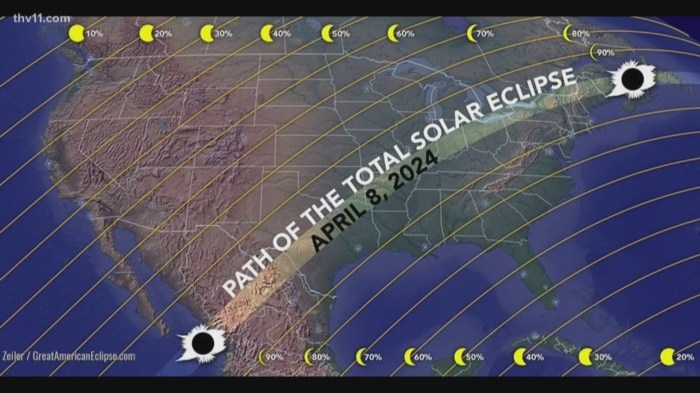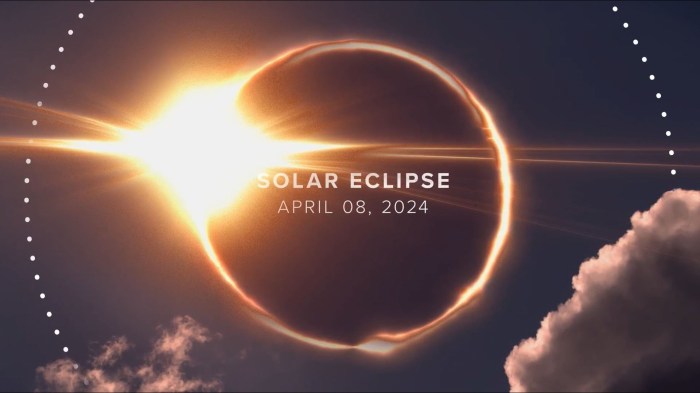Total Solar Eclipse April 8th
The total solar eclipse of April 8th, 2024, was a spectacular celestial event visible across a swathe of North America, offering a unique opportunity for scientific observation and public engagement with astronomy. This event provided a chance to witness the sun’s corona, a phenomenon rarely visible without specialized equipment.
Path of Totality for the April 8th Total Solar Eclipse
The path of totality, the area where the moon completely blocks the sun’s disk, traversed Mexico, the United States, and Canada. Beginning in the Pacific Ocean, the path entered Mexico near Mazatlán, crossed several US states including Texas, Oklahoma, Arkansas, Missouri, Illinois, Indiana, Ohio, Pennsylvania, New York, Vermont, and New Hampshire, before finally exiting over the Atlantic Ocean near Newfoundland, Canada. The duration of totality varied along this path, with longer periods experienced closer to the center line. This geographical variation provided diverse viewing opportunities.
Scientific Processes Behind a Total Solar Eclipse
A total solar eclipse occurs when the moon passes directly between the Earth and the sun, casting a shadow on Earth. The moon’s apparent size, as viewed from Earth, is sometimes larger than the sun’s, leading to a total eclipse. This alignment is not a frequent occurrence because the moon’s orbit is slightly tilted relative to Earth’s orbit around the sun. During totality, the sun’s corona, its outer atmosphere, becomes visible, revealing intricate structures and dynamic processes that are otherwise obscured by the sun’s bright surface. Scientists use these opportunities to study the sun’s magnetic field, solar flares, and coronal mass ejections.
Types of Solar Eclipses
There are three main types of solar eclipses: total, partial, and annular. A total solar eclipse occurs when the moon completely covers the sun’s disk. A partial solar eclipse happens when only a portion of the sun is obscured by the moon. An annular eclipse occurs when the moon is farther from Earth in its orbit, appearing smaller than the sun, resulting in a ring of sunlight visible around the moon’s silhouette. The April 8th eclipse was a total eclipse. The difference in experience is dramatic; a total eclipse plunges the area into near-darkness, revealing the corona, while a partial eclipse only dims the sunlight. An annular eclipse offers a unique “ring of fire” effect, but lacks the complete darkness and corona visibility of a total eclipse.
Viewing Experiences Along the Path of Totality
The experience of a total solar eclipse varies subtly depending on location within the path of totality. Those in the central path experienced the longest duration of totality and the darkest skies. Locations further from the center line saw a shorter duration and less pronounced darkness. Weather conditions also played a crucial role; clear skies provided optimal viewing, while cloud cover could significantly impact visibility. For example, observers in Paducah, Kentucky, in the center of the path, might have seen several minutes of totality, while observers near the edge of the path in a nearby town may have only witnessed a few seconds.
Historical Significant Total Solar Eclipses and Their Impact
Total solar eclipses have held cultural and scientific significance throughout history. The eclipse of 585 BC, documented by the Greek historian Herodotus, is believed to have ended a battle between the Medes and Lydians. Many ancient cultures viewed eclipses as ominous events, often attributing them to supernatural causes. However, modern science has utilized eclipses for groundbreaking discoveries. For example, observations during eclipses in the 19th century helped confirm Einstein’s theory of general relativity. More recently, eclipses have aided in advancements in solar physics and our understanding of the sun’s atmosphere. The detailed observations and data collected during past eclipses, combined with modern technology, continue to advance our scientific knowledge.
Safety Precautions During a Total Solar Eclipse

Witnessing a total solar eclipse is a breathtaking experience, but it’s crucial to prioritize eye safety. Looking directly at the sun, even during a partial eclipse, can cause serious and permanent eye damage, including solar retinopathy, which can lead to vision loss. Understanding and adhering to safe viewing practices is paramount to enjoying this celestial event without risking your eyesight.
The Dangers of Direct Sun Observation During an Eclipse
The sun’s intense radiation, even during an eclipse, can inflict irreparable harm to the retina, the light-sensitive tissue at the back of the eye. Unlike other burns, damage from solar radiation often occurs without immediate pain or discomfort, making it particularly dangerous. The sun’s rays contain ultraviolet (UV) and infrared (IR) radiation, both capable of causing severe retinal burns and long-term vision problems. Even a brief glance at the uneclipsed sun can cause damage, and this risk is amplified during an eclipse because people are more likely to look at the sun for extended periods due to the spectacle. The cumulative effect of staring at the sun, even for short intervals, can lead to severe vision impairment. Cases of permanent blindness have been documented following improper solar viewing during eclipses.
Appropriate Eye Protection for Solar Viewing
Safe solar viewing requires specialized eyewear that meets the ISO 12312-2 international safety standard. Regular sunglasses, even very dark ones, are absolutely insufficient and offer no protection against the sun’s harmful radiation. The only safe way to look directly at the sun during a partial eclipse is with certified solar viewing glasses or a solar filter. These filters are specifically designed to block out the harmful UV and IR radiation while allowing you to see the eclipse. They should be made of black polymer or aluminized Mylar. Always inspect your glasses before use; discard any that are scratched, damaged, or have pinholes. Homemade filters or other makeshift devices are highly discouraged and should never be used.
Safe Eclipse Viewing Techniques, Total Solar Eclipse April 8
A visual guide demonstrating safe viewing techniques would show: (1) a person wearing ISO 12312-2 certified eclipse glasses, looking directly at the sun during a partial eclipse; (2) a group of people using a pinhole projector, safely viewing the projected image of the sun onto a piece of white card; (3) a person using a properly filtered telescope to observe the eclipse. Remember, never look at the sun directly through binoculars, telescopes, or cameras without a specialized solar filter attached to the front of the device. Improper use of these optical aids can instantly cause severe eye damage.
Supervision of Children During the Eclipse
Children are especially vulnerable to eye damage from solar radiation, as they may be less aware of the risks. Adult supervision is crucial during the eclipse to ensure children are using appropriate eye protection and are not looking at the sun directly without certified glasses. Parents and guardians should explain the importance of eye safety and supervise children at all times. Engaging children in safe viewing activities, like using a pinhole projector, can make the experience educational and enjoyable without compromising their safety. Remember, a child’s developing eyes are particularly susceptible to damage, making careful supervision even more critical.
Experiencing the Total Solar Eclipse

Witnessing a total solar eclipse is an experience unlike any other. It’s a profound sensory event that transcends the purely visual, engaging all your senses and leaving an indelible mark on your memory. The dramatic shift in light, temperature, and even sound creates an atmosphere of awe and wonder, a moment of shared human experience across geographical boundaries.
The unique visual effects during totality are breathtaking. As the moon completely obscures the sun, the sky darkens dramatically, not to the level of night, but to a deep twilight. A 360-degree sunset effect becomes visible, painting the horizon in vibrant hues of orange, red, and purple. The sun’s corona, its outer atmosphere, becomes visible as a pearly white halo around the black disc of the moon. Prominences, massive eruptions of plasma from the sun’s surface, may also be visible as bright, reddish flames extending outwards. These fleeting visual phenomena are some of the most spectacular sights nature has to offer.
Changes in Temperature, Light, and Sound During Totality
The drop in temperature during totality is surprisingly noticeable. Even on a warm day, a distinct chill will permeate the air as the sun’s rays are blocked. The change in light is even more dramatic. The sudden, almost instantaneous plunge into twilight is often described as eerie yet beautiful. The familiar sounds of daytime birdsong will cease, replaced by an unusual quietude. Animals may react to the sudden change in light and sound, adding to the surreal atmosphere. One account from a previous eclipse describes the experience as a “moment of hushed reverence,” where the normal sounds of life fade into the background, highlighting the extraordinary nature of the event.
Recommended Activities to Enhance the Eclipse Viewing Experience
To fully appreciate this extraordinary event, careful planning and preparation are crucial. Before totality, take time to appreciate the gradual dimming of light and the changing landscape. Observe the shadows cast by the partially eclipsed sun. During totality, take in the full sensory experience: Feel the drop in temperature, listen to the unusual quiet, and let the sight of the corona and prominences overwhelm you. After totality, watch as the light slowly returns and the world comes alive again. Consider bringing binoculars (with proper solar filters) for a closer look at the sun’s corona, and a camera to capture the stunning visual spectacle, although no photograph can truly capture the emotional impact of the moment. Share the experience with friends and family, and create lasting memories.
Emotional Impact of Witnessing a Total Solar Eclipse
The emotional impact of a total solar eclipse is deeply personal, but many observers describe a sense of awe, wonder, and even reverence. The sheer scale and beauty of the event can evoke powerful feelings, a profound connection with the cosmos, and a humbling appreciation for the vastness of the universe. The temporary darkness, followed by the return of the sun, can be interpreted as a powerful symbol of renewal and rebirth. Many observers describe the experience as transformative, a moment of profound clarity and spiritual awakening. It’s an experience that transcends words, leaving viewers with a lasting sense of wonder and a deep appreciation for the natural world.